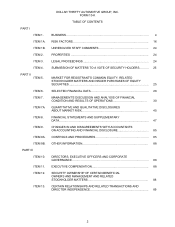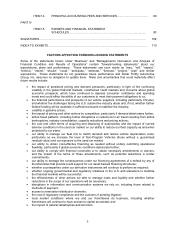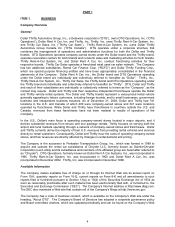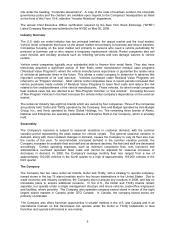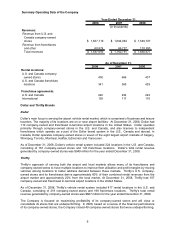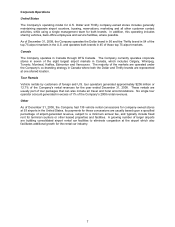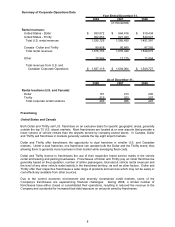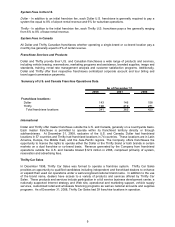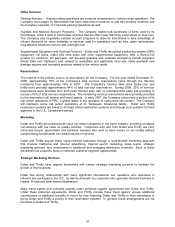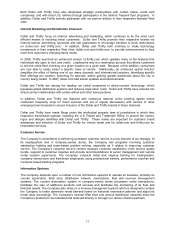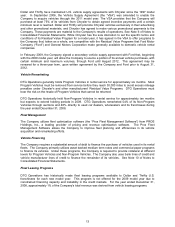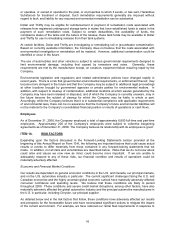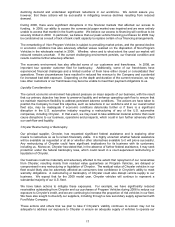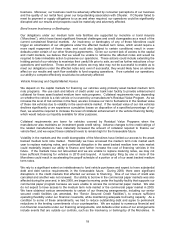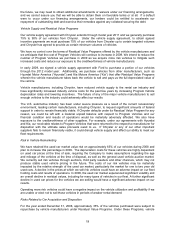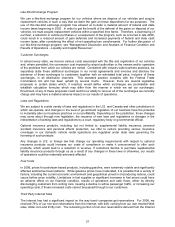Thrifty Car Rental 2008 Annual Report Download - page 14
Download and view the complete annual report
Please find page 14 of the 2008 Thrifty Car Rental annual report below. You can navigate through the pages in the report by either clicking on the pages listed below, or by using the keyword search tool below to find specific information within the annual report.During the fourth quarter of 2008, the Company began implementing a new counter automation system
designed to improve the flexibility to adapt to our changing environment.
The Company partners with Electronic Data Systems Corporation, a Hewlett Packard (“HP”) company,
and EDS Information Systems, L.L.C., also an HP company, (collectively, “EDS”), wherein EDS provides
the majority of the Company’s information technology (“IT”) services, including applications development
and maintenance, network, workplace and storage management, back-up and recovery and mid-range
hosting services. EDS is a leading global IT service company that manages and monitors the majority of
the Company’s data network and its daily information processing. The Company’s counter automation,
reservations, revenue management, Internet Web sites and fleet processing systems are housed in a
secure underground EDS facility in Oklahoma designed to withstand disasters.
U.S. franchisees receiving a certain volume of reservations are required to use an approved automated
counter system. In addition to providing an electronic data link with the Company’s worldwide
reservations centers, the automated counter system produces rental agreements and provides the
Company and its franchisees with customer and vehicle inventory information as well as financial and
operating reports.
Fleet Acquisition and Management
Vehicle Supply
For the 2008 model year, Chrysler vehicles represented approximately 76% of the total U.S. fleet
purchases by DTG Operations. DTG Operations also purchases vehicles from other vehicle
manufacturers. The Company expects that for the 2009 model year, Chrysler vehicles will continue to
represent a substantial majority of the total U.S. fleet of DTG Operations.
Residual Value Programs limit the Company’s residual value risk. The manufacturer either guarantees
the aggregate depreciated value upon resale of covered vehicles of a given model year, as is generally
the case under Chrysler’s program, or agrees to repurchase vehicles at specified prices during
established repurchase periods.
Chrysler, the Company’s primary supplier, sets the terms of its Residual Value Program, including
monthly depreciation rates, minimum and maximum holding periods and mileages, model mix
requirements, vehicle condition and other return requirements. Under the program, Chrysler agrees to
reimburse DTG Operations for any difference between the aggregate gross auction sale price of the
Program Vehicles for the particular model year and the vehicles’ aggregate predetermined residual value
and certain transportation, auction-related and interest costs.
DTG Operations also purchases Non-Program Vehicles, for which it bears the full residual value risk
because the vehicles are not covered by any Residual Value Program. It does so because Non-Program
Vehicles provide lower cost vehicles and allow the Company to reduce its risk related to the
creditworthiness of the vehicle manufacturers. Chrysler, the main provider of Non-Program Vehicles to
DTG Operations, does not set any terms or conditions on the resale of Non-Program Vehicles other than
requiring minimum holding periods. During 2008, approximately 65% of all vehicles operated by DTG
Operations were Non-Program Vehicles. For 2009, the Company expects to significantly increase its
level of vehicles acquired as Non-Program Vehicles.
Vehicle depreciation is the largest single cost element in the Company’s operations. Residual Value
Programs enable Dollar and Thrifty to determine their depreciation expense on Program Vehicles in
advance. The future percentages of Program Vehicles in our fleet will be dependent on the availability
and attractiveness of Residual Value Programs, and we expect percentages for 2009 to be significantly
lower than 2008 as we acquire more Non-Program Vehicles. Increasing the level of Non-Program
Vehicles allows the Company to maintain a larger fleet of vehicles at a lower cost without the related
vehicle manufacturer risk. However, by increasing the level of Non-Program Vehicles, the Company
increases its risk related to fluctuations in the residual value of the vehicle, which depends on such
factors as the general level of pricing in the automotive industry for both new and used vehicles, and
dependence on used car auction demand which impacts its ability to rapidly defleet.
12


